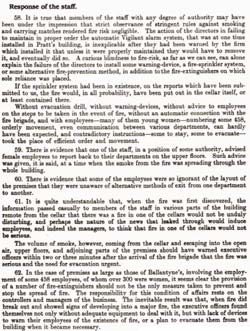Response of the staff
58. It is true that members of the staff with any degree of authority may have been under the impression that strict observance of stringent rules against smoking and carrying matches rendered fire risk negligible. The action of the directors in failing to maintain in proper order the automatic Vigilant alarm system, that was at one time installed in Pratt's building, is inexplicable after they had been warned by the firm which installed it that unless it were properly maintained they would have to remove it, and eventually did so. A curious blindness to fire-risk, as far as we can see, can alone explain the failure of the directors to install some warning-device, a fire-sprinkler system, or some alternative fire-prevention method, in addition to the fire-extinguishers on which sole reliance was placed.
If the sprinkler system had been in existence, on the reports which have been submitted to us, the fire would, in all probability, have been put out in the cellar itself, or at least contained there.
Without evacuation drill, without warning-devices, without advice to employees on the steps to be taken in the event of fire, without an automatic connection with the fire brigade, and with employees—many of them young women—numbering some 458, orderly movement, even communication between various departments, can hardly have been expected, and contradictory instructions—some to stay, some to evacuate— took the place of efficient order and movement.
59. There is evidence that one of the staff, in a position of some authority, advised female employees to report back to their departments on the upper floors. Such advice was given, it is said, at a time when the smoke from the fire was spreading through the whole building.
60. There is evidence that some of the employees were so ignorant of the layout of the premises that they were unaware of alternative methods of exit from one department to another.
61. It is quite understandable that, when the fire was first discovered, the information passed casually to members of the staff in various parts of the building remote from the cellar that there was a fire in one of the cellars would not be unduly disturbing, and perhaps the nature of the news that leaked through would induce employees, and indeed the managers, to think that fire in one of the cellars would not be serious.
The volume of smoke, however, coming from the cellar and escaping into the open air, upper floors, and adjoining parts of the premises should have warned executive officers within two or three minutes after the arrival of the fire brigade that the fire was serious and the need for evacuation urgent.
62. In the case of premises as large as those of Ballantyne’s, involving the employment of some 458 employees, of whom over 300 were women, it seems clear the provision of a number of fire-extinguishers should not be the only measure taken to prevent and stop the spread of fire. The responsibility for this condition of affairs rests on the controllers and managers of the business. The inevitable result was that, when fire did break out and showed signs of developing into a major fire, the executive officers found themselves not only without adequate equipment to deal with it, but with lack of devices to warn their employees of the existence of fire, or a plan to evacuate them from the building when it became necessary.
Sources
Report of the Royal Commission, New Zealand Parliament. Appendices to the Journals of the House of Representives, 1948. vol.V, H-47. p.30-31.


 Discover your family’s history at our libraries
Discover your family’s history at our libraries

